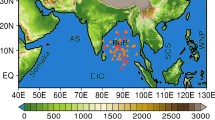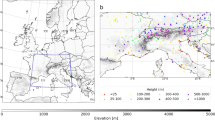Abstract
The formation and intensification of tropical cyclones (TCs) are greatly influenced by environmental thermodynamic and dynamic factors. The Bay of Bengal (BoB) region showed a significant amount of month-wise variability in terms of TC activity. We evaluated Emanuel’s maximum potential intensity (EMPI) model of TCs for the BoB region. A significant discrepancy was observed between month-wise EMPI distribution and TC formation locations, especially during the monsoon (June–September). Thermodynamic parameters that influence the EMPI, such as sea surface temperature, relative humidity and thermodynamic efficiency, were also examined. The EMPI during monsoon was lowest compared to pre-monsoon (March–May) and post-monsoon (October–December). The lower EMPI during monsoon was due to increased relative humidity, whereas higher sea surface temperature and lower relative humidity resulted in higher EMPI during pre-monsoon and post-monsoon, respectively. The most striking observation was that the thermodynamic efficiency was negatively correlated with EMPI during the monsoon. It was further observed that TCs were achieved only 42.82% of their estimated EMPI. We have introduced a modified maximum potential intensity (MMPI) model incorporating dynamic factors such as vertical wind shear. The MMPI significantly reduced the absolute difference between the observed and estimated TC peak intensity to 2.61 kts from 60.44 kts for the EMPI. The MMPI also efficiently portrayed the month-wise spatial variability of TC formation locations over the BoB.
Research highlights
-
1.
Maximum potential intensity (MPI) varies significantly season-wise over the Bay of Bengal.
-
2.
Tropical cyclones only archive half of their theoretical MPI due to negative impact of vertical wind shear.
-
3.
Inclusion of dynamic factors such as vertical wind shear in MPI model can significantly reduce the deviation between MPI and TC intensity.











Similar content being viewed by others
References
Alam M M, Hossain M A and Shafee S 2003 Frequency of Bay of Bengal cyclonic storms and depressions crossing different coastal zones; Int. J. Climatol. 23 1119–1125.
Bister M and Emanuel K A 1998 Dissipative heating and hurricane intensity; Meteorol. Atmos. Phys. 65 233–240.
Bister M and Emanuel K A 2002 Low frequency variability of tropical cyclone potential intensity. 1. Interannual to interdecadal variability; J. Geophys. Res. 107 4801.
Briegel L M and Frank W M 1997 Large-scale influences on tropical cyclogenesis in the western north Pacific; Mon. Weather Rev. 125 1397–1413.
Camargo S J, Emanuel K A and Sobel A H 2007 Use of a genesis potential index to diagnose ENSO effects on tropical cyclone genesis; J. Clim. 20 4819–4834.
Camp J P and Montgomery M T 2001 Hurricane maximum intensity: Past and present; Mon. Weather Rev. 129 1704–1717.
Chan J C L 2005 The physics of tropical cyclone motion; Ann. Rev. Fluid Mech. 37 99–128.
DeMaria M 1996 The effect of vertical wind shear on tropical cyclone intensity change; J. Atmos. Sci. 53(14) 2076–2087.
DeMaria M 2001 A tropical cyclone genesis parameter for the tropical Atlantic; Weather Forecast. 16 219–233.
DeMaria M and Kaplan J 1994 Sea surface temperature and the maximum intensity of Atlantic tropical cyclones; J. Clim. 7 1324–1334.
Dullaart J C M, Muis S, Bloemendaal N and Aerts J C J H 2020 Advancing global storm surge modelling using the new ERA5 climate reanalysis; Clim. Dyn. 54 1007–1021.
Elsberry R L and Jeffries R 1996 Vertical wind shear influences on tropical cyclone formation and intensification during TCM-92 and TCM-93; Mon. Weather Rev. 124 1374–1387.
Emanuel K A 1986 An air–sea interaction theory of tropical cyclones Part I: Steady-state maintenance; J. Atmos. Sci. 43(6) 585–605.
Emanuel K A 1988 The maximum intensity of hurricanes; J. Atmos. Sci. 45(7) 1143–1155.
Emanuel K A 1991 The theory of hurricanes; Annu. Rev. Fluid Mech. 23 179–196.
Emanuel K A 1995 Sensitivity of tropical cyclones to surface exchange coefficients and a revised steady-state model incorporating eye dynamics; J. Atmos. Sci. 52(22) 3969–3976.
Emanuel K A 2000 A statistical analysis of hurricane intensity; Mon. Weather Rev. 128 1139–1152.
Emanuel K 2003 Tropical Cyclones; Ann. Rev. Earth Planet. Sci. 31 75–104.
Felton C S, Subahmanyam B and Murty V S N 2013 ENSO modulated cyclogenesis over the Bay of Bengal; J. Climatol. 26 9806–9818.
Frank W M and Richie E A 2001 Effects of vertical wind shear on the intensity and structure of numerically simulated hurricanes; Mon. Weather Rev. 129 2249–2269.
Free M, Bister M and Emanuel K 2004 Potential intensity of tropical cyclones: Comparison of results from radiosonde and reanalysis data; J. Clim. 17 1722–1727.
Gadgil S 2003 The Indian monsoon and its variability; Ann. Rev. Earth Planet. Sci. 31 429–467.
Garner S 2015 The relationship between hurricane potential intensity and CAPE; J. Atmos. Sci. 72(1) 141–163.
Ge X, Li T and Peng M 2013 Effects of vertical wind shears and midlevel dry air on tropical cyclone developments; J. Atmos. Sci. 70 3859–3875.
Gilford D M 2021 pyPI (v1.3): Tropical cyclone potential intensity calculations in Python; Geosci. Model Dev. 14 2351–2369.
Girishkumar M S, Thanga Prakash V P and Ravichandran M 2015 Influence of pacific decadal oscillation on the relationship between ENSO and tropical cyclone activity in the Bay of Bengal during October–December; Clim. Dyn. 44 3469–3479.
Gray W M 1968 Global view of the origin of tropical disturbances and storms; Mon. Weather Rev. 96 669–700.
Gray W M 1975 Tropical cyclone genesis; Atmospheric science paper no. 234, Colorado State University.
Hersbach H et al. 2020 The ERA% global reanalysis; Quart. J. Roy. Meteorol. Soc. 146 1999–2049.
Hill K A and Lackmann G M 2009 Influence of Environmental Humidity on Tropical Cyclone Size; Mon. Weather Rev. 137 3294–3315.
Hobgood J S 1986 The influence of relative humidity on the development of tropical cyclones; Phys. Geogr. 7(4) 283–291.
Huanghfu J, Chen W, Ma T and Huang R 2017 Influences of sea surface temperature in the tropical pacific and Indian oceans on tropical cyclone genesis over the western north pacific in May; Clim. Dyn. 51 1915–1926.
Huanghfu J, Chen W, Ma T and Huang R 2018 Interdecadal Variation of Tropical Cyclone genesis and its relationship to the convective activities over the Central pacific; Clim. Dyn. 50 1439–1450.
Kolstad E W 2020 Prediction and precursors of Idai and 38 other tropical cyclones and storms in the Mozambique Channel; Quart. J. Roy. Meteorol. Soc. 147(734) 45–57.
Kossin J P and Camargo S J 2009 Hurricane track variability and secular potential intensity trends; Clim. Chang. 97 329–337.
Kotal S D, Kundu P K and Roy Bhowmik S K 2009 Analysis of cyclogenesis parameter for developing and nondeveloping low-pressure systems over the Indian sea; Nat. Hazards 50 389–402.
Li Z, Yu W, Li T, Murty V S N and Tangang F 2013 Bimodal character of cyclone climatology in the Bay of Bengal modulated by monsoon seasonal cycle; J. Clim. 26 1033–1046.
Li Y, Li T, Fu C and Hsu P 2018 Near-equatorial tropical cyclone formation in western north Pacific: Peak season and controlling parameter; Clim. Dyn. 52 2765–2773.
Ma Z, Fei J, Huang X and Cheng X 2012 Sensitivity of tropical cyclone intensity and structure to vertical resolution in WRF; Asia-Pac. J. Atmos. Sci. 48(1) 67–81.
Mahala B K, Nayak B K and Mohanty P K 2015 Impacts of ENSO and IOD on tropical cyclone activity in the Bay of Bengal; Nat. Hazards 75 1105–1125.
Malakar P, Kesarkar A P, Bhate J N, Singh V and Deshamukhya A 2020 Comparison of reanalysis datasets to comprehend the evolution of tropical cyclones over North Indian Ocean; Earth Space Sci. 7 e2019EA000978.
Mohanty U C and Gupta A 1997 Deterministic methods for prediction of tropical cyclones tracks; Mausam 48(2) 257–272.
Nath S, Kotal S D and Kundu P K 2013 Analysis of a genesis potential parameter during pre-cyclone watch period over the Bay of Bengal; Nat. Hazards 65 2253–2265.
Pal A and Chatterjee S 2021 Influence of seasonal variability in the environmental factors on tropical cyclone activity over the Bay of Bengal region; Spat. Inf. Res. 29 673–684.
Palmen E 1948 On the formation and structure of tropical hurricanes; Geophysica 3 26–38.
Park M-S, Elsberry R L and Harr P A 2012 Vertical wind shear and ocean heat content as environmental modulators of western north pacific tropical cyclone intensification and decay; Trop. Cyclone Res. Rev. 1(4) 448–457.
Paterson L A, Hanstrum B N, Davidson N E and Weber H C 2005 Influence of environmental vertical wind shear on the intensity of hurricane-strength tropical cyclones in the Australian Region; Mon. Weather Rev. 113 3644–3660.
Schade L R 2000 Tropical cyclone intensity and sea surface temperature; J. Atmos. Sci. 57 3122–3130.
Subbaramayya I and Rao S R M 1984 Frequency of Bay of Bengal cyclones in the post-monsoon season; Mon. Weather Rev. 112 1640–1642.
Sun Z, Zhang B, Zhang J A and Perrie W 2019 Examination of surface wind asymmetry in tropical cyclones over the northwest Pacific ocean using SMAP observations; Remote. Sens. 11 2604.
Tonkin H, Holland G J, Holbrook N and Henderson-Sellers A 2000 An evaluation of thermodynamic estimates of climatological maximum potential tropical cyclone intensity; Mon. Weather Rev. 128 746–762.
Tsutsui J 2010 Changes in potential intensity of tropical cyclones approaching Japan due to anthropogenic warming in sea surface and upper-air temperatures; J. Meteorol. Soc. Japan 88(3) 263–284.
Uddin M J, Nasrin Z M and Li Y 2021 Effects of vertical wind shear and storm motion on tropical cyclone rainfall asymmetries over the North Indian Ocean; Dyn. Atmos. Ocean. 93 101196.
Walsh K J and Ryan B F 2000 Tropical cyclone intensity increase near Australia as a result of climate change; J. Clim. 13(16) 3029–3036.
Wang B, Elsberry R L, Wang Y and Wu L 1998 Dynamics in tropical cyclone motion: A review; Chin. J. Atmos. Sci. 22 535–547.
Wang Y, Rao Y, Tan Z-M and Schonemann D A 2015 Statistical analysis of the effects of vertical wind shear on tropical cyclone intensity change over the Western North Pacific; Mon. Weather Rev. 143 3434–3453.
Wu L et al. 2012 Relationship of environmental relative humidity with North Atlantic tropical cyclone intensity and intensification rate; Geophys. Res. Lett. 39 L20809.
Xu J, Wang Y and Yang C 2019 Factors affecting the variability of maximum potential intensity (MPI) of tropical cyclones over the North Atlantic; J. Geophys. Res.: Atmos. 124 6654–6668.
Yoshida R and Ishikawa H 2013 Environmental factors contributing to tropical cyclone genesis over the western North Pacific; Mon. Wea. Rev. 141 451–467.
Yu J and Wang Y 2009 Response of tropical cyclone potential intensity over the north Indian Ocean to global warming; Geophys. Res. Lett. 36 L03709, https://doi.org/10.1029/2008GL036742.
Zehr R M 1992 Tropical cyclogenesis in the western North Pacific; NOAA Technical Report NESDIS 61. Washington, D.C.
Zeng Z, Wang Y and Wu C 2007 Environmental dynamical control of tropical cyclone intensity – An observational study; Mon. Weather Rev. 135 38–59.
Zeng Z, Chen L and Wang Y 2008 An observational study of environmental dynamical control of tropical cyclone intensity in the Atlantic; Mon. Weather Rev. 136 3307–3322.
Acknowledgement
The first author is thankful to the University Grants Commission of India for funding the research work under the scheme of ‘JRF in Science, Humanities & Social Sciences’.
Author information
Authors and Affiliations
Contributions
Conceptualization of the work, data analysis and manuscript writing have been done by the first author. The second author has approved the manuscript and given critical suggestions all along the work.
Corresponding author
Additional information
Communicated by Parthasarathi Mukhopadhyay
Rights and permissions
About this article
Cite this article
Pal, A., Chatterjee, S. Influence of vertical wind shear on the maximum potential intensity of tropical cyclones over the Bay of Bengal region. J Earth Syst Sci 131, 255 (2022). https://doi.org/10.1007/s12040-022-02003-y
Received:
Revised:
Accepted:
Published:
DOI: https://doi.org/10.1007/s12040-022-02003-y




